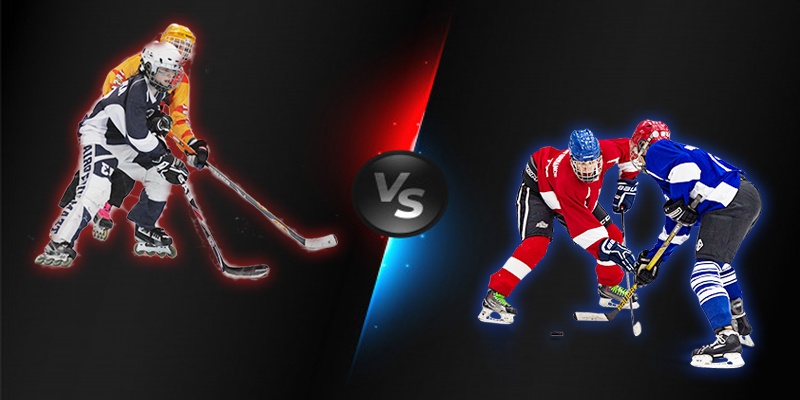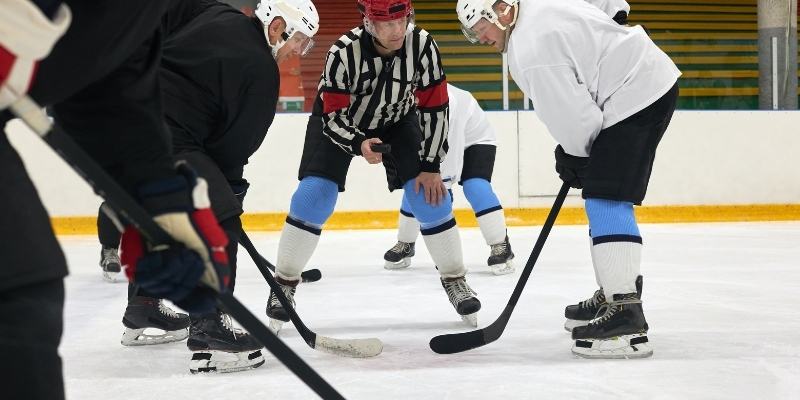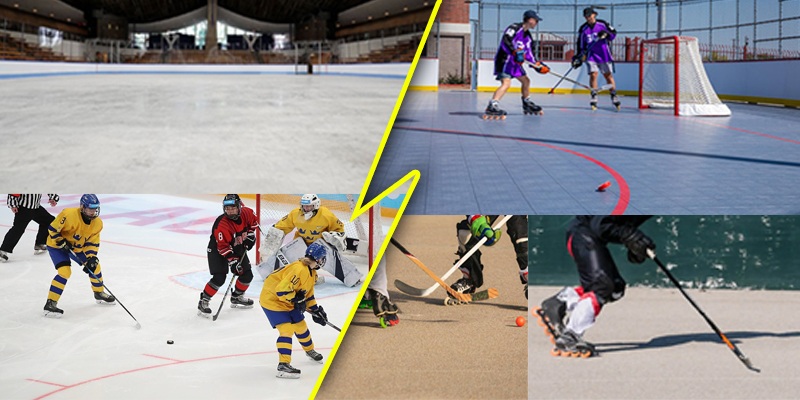Hockey is a widely played sport that comes in various forms, with ice hockey being the most popular. On the other hand, roller hockey has been gaining popularity in North America in recent years. There are some parallels between inline hockey and ice hockey, but there are also significant differences.
These differences distinguish roller hockey as a different game with new obstacles and scenarios, resulting in a unique game from ice hockey, yet equally enjoyable! This article highlights the differences and similarities between ice hockey vs roller hockey.
What is Ice Hockey?
Ice hockey, commonly known as the world’s fastest physical sport, is primarily played in North America, Canada, and Europe. It is said to have started in Nova Scotia, on the east coast, in the early 18th century and has since mostly been an enjoyable winter activity.
Ice hockey is played on an ice-covered surface with ice skates on the feet and sticks to hit the ball or puck and score against the other team. Since the 1920s, this game has garnered enormous popularity among the public and has been played at an international level at the Olympics.
What is roller hockey?
Also know as inline hockey, roller hockey is a fast-paced sport in which two teams compete simultaneously with up to 5 roller players and one goalkeeper. The well-padded roller hockey players attempt to take or keep control of a ball or puck and score the opposing net, guarded by a goalkeeper, using long curved sticks. Inline hockey is a great way to keep playing hockey even in the summer. There are several major tournaments for roller hockey including the roller hockey league and play mens league.
Ice Hockey Vs. Roller Hockey: The Difference
Below are the major differences between ice hockey and roller hockey.
1. Playing Surfaces
One significant distinction between ice hockey and roller hockey is the playing surface. Ice hockey, on the other hand, is played on hockey rinks. During typical play, each team has six skaters on the ice rink, one of whom is the goalkeeper.
On the other hand, most inline hockey games and big competitions in North America are played on sport courts. A sport court is a set of interlocking plastic tiles that helps the puck glide across the surface. It also allows players to slide when they come to a halt. They can practically “ice hockey” halt and change directions in a split second, which is a significant advantage. These sport court surfaces are as large as a regular ice hockey rink and properly fit the measurements.
Another obvious difference, apart from the fact that one is ice and the other is tile, is the blue lines that isn’t found on roller hockey rinks. This is because there are no off-sides in roller hockey. There is also no frosting, making inline hockey a more strategic and possession game.
2. The Size of the Team
Roller hockey have smaller teams, with 16 skaters (which is the maximum at IIHF competitions.) The games are four-on-four with a goalie. This differs from ice hockey, which is played 5 on 5 with a goalkeeper. Although there is a 16 skaters limit, most teams only have within 10 to 12 skaters and one or two goalies. Players may get creative with all the extra room and come up with some fantastic plays.
3. The Rules
Ice hockey also has a very different dynamic than the free zone roller game. Roller hockey’s offensive technique can be similar to basketball’s open court tactics. Here’s how ice hockey differs from roller hockey in terms of rules.
In ice hockey, the referee and two linesmen devote around 85% of their attention to off-side and icing stoppages and restarts of play. Roller hockey, which employs two refs and no linesmen, eliminates this problem. This results in a faster-paced game, more scoring opportunities, and increased fan interest.
Ice hockey teams can only have six players on the ice at a time, including the goaltender, but roller hockey teams can only have five.
Ice hockey players are allowed to board check, which frequently leads to retaliatory fights and other forms of game violence. Fighting is illegal and harshly penalized under roller hockey regulations, and checking is not permitted.
On-ice icing is not permitted unless the offending team has fewer players on the ice due to penalties. However, roller hockey has no such passing limitation, resulting in a faster breaking offensive and less game stoppage.
4. The Game Time
Roller hockey games are played in two – 20 minute half for world championship games, whereas ice hockey games are played in three – 20 minute quarters.
5. Roller Hockey Stick Vs Ice Hockey
The sticks for ice hockey and roller hockey are similar. However, the stick handling differs. Ice hockey sticks are subjected to far more stress compared to roller hockey sticks. Also, the quality of the shaft and blade can significantly impact performance and durability. A higher-quality stick will provide faster shots and a longer lifespan.
Most ice hockey sticks can be repurposed for inline hockey, but not the other way around. Because of the ice hockey puck weight and the speed, it moves on the ice, the ABS blade on a roller hockey stick would not work for ice hockey.
6. Ice Hockey Equipment Vs. inline Hockey Equipment
The skates are the most visible distinction between inline hockey and ice hockey, with roller skates having a chassis and wheels rather than a blade holder/blade holder.
However, the boots are nearly identical, to the point where ice hockey skates are frequently changed to inline skates.
Similarities Between Ice Hockey and Roller Hockey
Ice hockey and inline hockey have a lot in common when it comes to the playing style, pitch, equipment, and clothing. For instance, ball/puck, blocker glove, catching glove, goalie stick, gloves, elbow pads, helmets, nets, jerseys, and shoulder pads are all similar.
The substitution for both sports is also comparable. Anyone who has played roller hockey can quickly adapt to ice hockey and vice versa.
Does Playing Roller Hockey Help Ice Hockey?
Roller hockey is an excellent way to prepare for ice hockey. It can help you improve your skating, balance, and muscle strength when you can’t get on the ice.
Despite its many variances, this sport offers a distinct form of hockey to the regular ice hockey player. It can also serve as an excellent introduction to hockey for someone who is just familiar with rollerblading.
Roller hockey encourages puck management, puck support, and finding free space are all encouraged in roller hockey. There’s nowhere to hide.
All of the players are exposed because there are no off-sides or icing. So you’re forced to communicate, pick up an open man, and win those one-on-one battles.
Conclusion
Both Ice hockey, roller hockey, and other hockey games are beneficial health-wise. In addition to the overall body benefits of the exercise, playing a hockey game aids in the release of endorphins, that helps in combating stress, depression, and anxiety.




